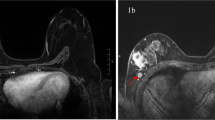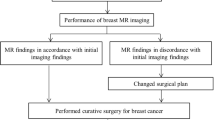Abstract
This study was initiated to clarify the ability of magnetic resonance imaging (MRI) in defining breast carcinoma extension by comparing MRI to detailed histopathological analysis. Mastectomy (n=14) or quadrantectomy (n=44) specimens were sub-serially sectioned and mapped in detail in 58 breast cancer patients. Morphologically, we classified the lesions utilizing MRI into three patterns in relation to their histology. Numerically, we assessed the maximum distance of carcinoma extension using MRI, mammography, and ultrasonography (US). Linear regression was calculated for each of the three imaging measurements versus histopathological measurements.
Three imaging patterns were observed by MRI, (1) localized (n=30), (2) segmentally extended (n=19), and (3) irregularly extended (n=5). The localized pattern showed a distinct focal mass, but in 10 cases, microscopic ductal carcinoma in situ (DCIS), or invasive lobular carcinoma, which were not depicted by MRI, existed. The segmentally extended pattern showed diffuse enhancement along duct–lobular segments, forming a ‘cone’ shape. Histologically, pure (n=4) or predominant (n=10) DCIS was distributed segmentally. The irregularly extended pattern showed thick branches extending out from the index tumor which were histologically revealed to be stromal invasion of ductal carcinoma. From the results of linear regressions, MRI was the most accurate modality in histologically measuring the extent of the cancer. When cases were limited to patients who were classified into segmentally or irregularly extended pattern by MRI (n=24), MRI was more accurate than mammography and US, even if they were combined (P<0.05).
MRI may provide additional information concerning carcinoma extension prior to surgery, especially in patients classified into ‘extended patterns’ by MRI.
Similar content being viewed by others
References
Fisher B, Anderson S, Redmond CK, Wolmark N, Wickerham DL, Cronin WM: Reanalysis and results after 12 years of follow-up in a randomized clinical trial comparing total mastectomy with lumpectomy with or without irradiation in the treatment of breast cancer. N Engl J Med 333: 1456–1461, 1995
Veronesi U, Salvadori B, Luini A, Greco M, Saccozzi R, del Vecchio M, Mariani L, Zurrida S, Rilke F: Breast conservation is a safe method in patients with small cancer of the breast. Long-term results of three randomised trials on 1,973 patients. Eur J Cancer 31: 1574–1579, 1995
Early Breast Cancer Trialists' Collaborative Group: Effects of radiotherapy and surgery in early breast cancer: an overview of the randomized trials. N Engl J Med 333: 1444–1455, 1995
Schnitt SJ, Abner A, Gelman R, Connolly JL, Recht A, Duda RB, Eberlein TJ, Mayzel K, Silver B, Harris JR: The relationship between microscopic margins of resection and the risk of local recurrence in patients with breast cancer treated with breast-conserving surgery and radiation therapy. Cancer 74: 1746–1751, 1994
Smitt MC, Nowels KW, Zdeblick MJ, Jeffrey S, Carlson RW, Stockdale EF, Goffinet DR: The importance of the lumpectomy surgical margin status in long term results of breast conservation. Cancer 76: 259–267, 1995
Mariani L, Salvadori B, Marubini E, Conti AR, Rovini D, Cusumano F, Rosolin T, Andreola S, Zucali R, Rilke F, Veronesi U: Ten year results of a randomised trial comparing two conservative treatment strategies for small size breast cancer. Eur J Cancer 34: 1156–1162, 1998
DiBiase SJ, Komarnicky LT, Schwartz GF, Xie Y, Mansfield CM: The number of positive margins influences the outcome of women treated with breast preservation for early stage breast carcinoma. Cancer 82: 2212–2220, 1998
Fisher B: Lumpectomy versus quadrantectomy for breast conservation: a critical appraisal. Eur J Cancer 31: 1567–1569, 1995
Kaiser WA: MR Mammography (MRM). Springer-Verlag, Berlin, 1993, pp 37–66
Heywang-Kobrunner SH: Contrast-enhanced magnetic resonance imaging of the breast. Invest Radiol 29: 94–104, 1994
Fobben ES, Rubin CZ, Kalisher L, Dembner AG, Seltzer MH, Santoro EJ: Breast MR imaging with commercially available techniques: radiologic–pathologic correlation. Radiology 196: 143–152, 1995
Orel SG, Schnall MD, LiVolsi VA, Troupin RH: Suspicious breast lesions: MR imaging with radiologic–pathologic correlation. Radiology 190: 485–493, 1994
Stomper PC, Herman S, Klippenstein DL, Winston JS, Edge SB, Arredondo MA, Mazurchuk RV, Blumenson LE: Suspect breast lesions: findings at dynamic gadolinium-enhanced MR imaging correlated with mammographic and pathologic features. Radiology 197: 387–395, 1995
Egan RL: Multicentric breast carcinomas: clinical– radiographic–pathologic whole organ studies and 10-year survival. Cancer 49: 1123–1130, 1982
Page DL, Anderson TJ, Rogers LW: Epithelial hyperplasia and carcinoma in situ (CIS). In: Page DL, Anderson TJ (eds) Diagnostic Histopathology of the Breast. Churchill Livingstone, Edinburgh, 1987, pp 120–192
Gribbestad IS, Nilsen G, Fjosne H, Fougner R, Haugen OA, Petersen SB, Rinck PA, Kvinnsland S: Contrast-enhanced magnetic resonance imaging of the breast. Acta Oncol 31: 833–842, 1992
Davis PL, Staiger MJ, Harris KB, Ganott MA, Klementaviciene J, McCarty KS Jr, Tobon H: Breast cancer measurements with magnetic resonance imaging, ultrasonography, and mammography. Breast Cancer Res Treat 37: 1–9, 1996
Harms SE, Flamig DP, Hesley KL, Meiches MD, Jensen RA, Evans WP, Savino DA, Wells RV: MR imaging of the breast with rotating delivery of excitation off resonance: clinical experience with pathologic correlation. Radiology 187: 493–501, 1993
Boetes C, Mus RDM, Holland R, Barentsz JO, Strijk SP, Wobbes T, Hendriks JHCL, Ruys SHJ: Breast tumors: comparative accuracy of MR imaging relative to mammography and US for demonstrating extent. Radiology 197: 743–747, 1995
Mumtaz H, Hall-Craggs MA, Davidson T, Walmsley K, Thurell W, Kissin MW, Taylor I: Staging of symptomatic primary breast cancer with MR imaging. AIR 169: 417–424, 1997
Ohuchi N, Furuta A, Mori S: Management of ductal carcinoma in situ with nipple discharge. Cancer 74: 1294–1302, 1994
Holland R, Veling SHJ, Mravunac M, Hendriks JHCL: Histologic multifocality of Tis, T1–2 breast carcinomas. Cancer 56: 979–990, 1985
Gilles R, Zafrani B, Guinebretiere J-M, Meunier M, Lucidarme O, Tardivon AA, Rochard F, Vanel D, Neuenschwander S, Arriagada R: Ductal carcinoma in situ: MR imaginghistopathologic correlation. Radiology 196: 415–419, 1995
Orel SG, Mendonca MH, Reynolds C, Schnall MD, Solin LI, Sullivan DC: MR imaging of ductal carcinoma in situ. Radiology 202: 413–420, 1997
Author information
Authors and Affiliations
Rights and permissions
About this article
Cite this article
Amano, G., Ohuchi, N., Ishibashi, T. et al. Correlation of three-dimensional magnetic resonance imaging with precise histopathological map concerning carcinoma extension in the breast. Breast Cancer Res Treat 60, 43–55 (2000). https://doi.org/10.1023/A:1006342711426
Issue Date:
DOI: https://doi.org/10.1023/A:1006342711426




